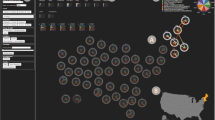Abstract
Regularities exist in datasets describing spatially distributed physical phenomena. Human experts often understand and verbalize the regularities as abstract spatial objects evolving coherently and interacting with each other in the domain space. We describe a novel computational approach for identifying and extracting these abstract spatial objects through the construction of a hierarchy of spatial relations. We demonstrate the approach with an application to finding troughs in weather data sets.
Access this chapter
Tax calculation will be finalised at checkout
Purchases are for personal use only
Preview
Unable to display preview. Download preview PDF.
Similar content being viewed by others
References
C. Bailey-Kellogg and F. Zhao. Influence-based model decomposition. In Proceedings of AAAI, to appear, 1999.
J.G Dunham. Optimum uniform piecewise linear approximation of planar curves. IEEE Trans. Pattern Analysis Mach. Intell., PAMI-8:67–75, 1986.
K. Forbus, P. Nielsen, and B. Faltings. Qualitative kinematics: A framework. In Proceedings of AAAI, 1987.
X. Huang and F. Zhao. Segmentation of planar curves and the iterative thresholding technique. Technical Report OSU-CISRC-3/99-TR07, CIS, Ohio State Univ, 1999.
L. Joskowicz and E. Sacks. Computational kinematics. Artificial Intelligence, 51:381–416, 1991.
E. M. Knorr and R. T. Ng. Finding aggregate proximity relationships and commonalities in spatial data mining. IEEE Trans. on Knowledge and Data Engineering, 8:884–897, December 1996.
M. Lundell. A qualitative model of physical fields. In Proceedings of AAAI, 1996.
R. T. Ng and J. Han. Efficient and Effective Clustering Methods for Spatial Data Mining. In Proceedings of the Twentieth International Conference on Very Large Databases, pages 144–155, Santiago, Chile, 1994.
T. Pavlidis and S. L. Horowitz. Segmentation of plane curves. IEEE Trans. Computer, C-22:860–870, 1974.
R. Samtaney, D. Silver, N. Zabusky, and J. Cao. Visualizing features and tracking their evolution. IEEE Computer Magazine, July 1994.
Air Weather Service. Back to basics. In AWS FOT Seminar STT-Q9-0004, 1975.
D. Silver and N. Zabusky. Quantifying visualizations for reduced modeling in nonlinearscience: Extracting structures from data sets. Journal of Visual Communication and Image, 4:46–61, 1993.
S. Ullman. Visual routines. Cognition, 18, 1984.
S. Ullman. Chapter 2: Approaches to object recognition. In High Level Vision. MIT Press, 1996.
J. A. Ventura and J. M. Chen. Segmentation of two-dimensional curve contours. Pattern Recognition, 28:1129–1140, 1992.
K. M. Yip. KAM: A system for intelligently guiding numerical experimentation by computer. MIT Press, 1991.
K. M. Yip. Structural inferences from massive datasets. In Proceedings of IJCAI, 1997.
K. M. Yip and F. Zhao. Spatial aggregation: theory and applications. J. Artificial Intelligence Research, 5, 1996.
F. Zhao. Extracting and representing qualitative behaviors of complex systems in phase spaces. Artificial Intelligence, 69(1-2):51–92, 1994.
F. Zhao, Intelligent simulation in designing complex dynamical control systems. Book chapter in Artificial Intelligence in Industrial Decision Making, Control, and Automation, Tzafestas and Verbruggen (eds.), pp. 127–158, Kluwer, 1995.
Author information
Authors and Affiliations
Editor information
Editors and Affiliations
Rights and permissions
Copyright information
© 1999 Springer-Verlag Berlin Heidelberg
About this paper
Cite this paper
Huang, X., Zhao, F. (1999). “Seeing“ Objects in Spatial Datasets. In: Hand, D.J., Kok, J.N., Berthold, M.R. (eds) Advances in Intelligent Data Analysis. IDA 1999. Lecture Notes in Computer Science, vol 1642. Springer, Berlin, Heidelberg. https://doi.org/10.1007/3-540-48412-4_10
Download citation
DOI: https://doi.org/10.1007/3-540-48412-4_10
Published:
Publisher Name: Springer, Berlin, Heidelberg
Print ISBN: 978-3-540-66332-4
Online ISBN: 978-3-540-48412-7
eBook Packages: Springer Book Archive




